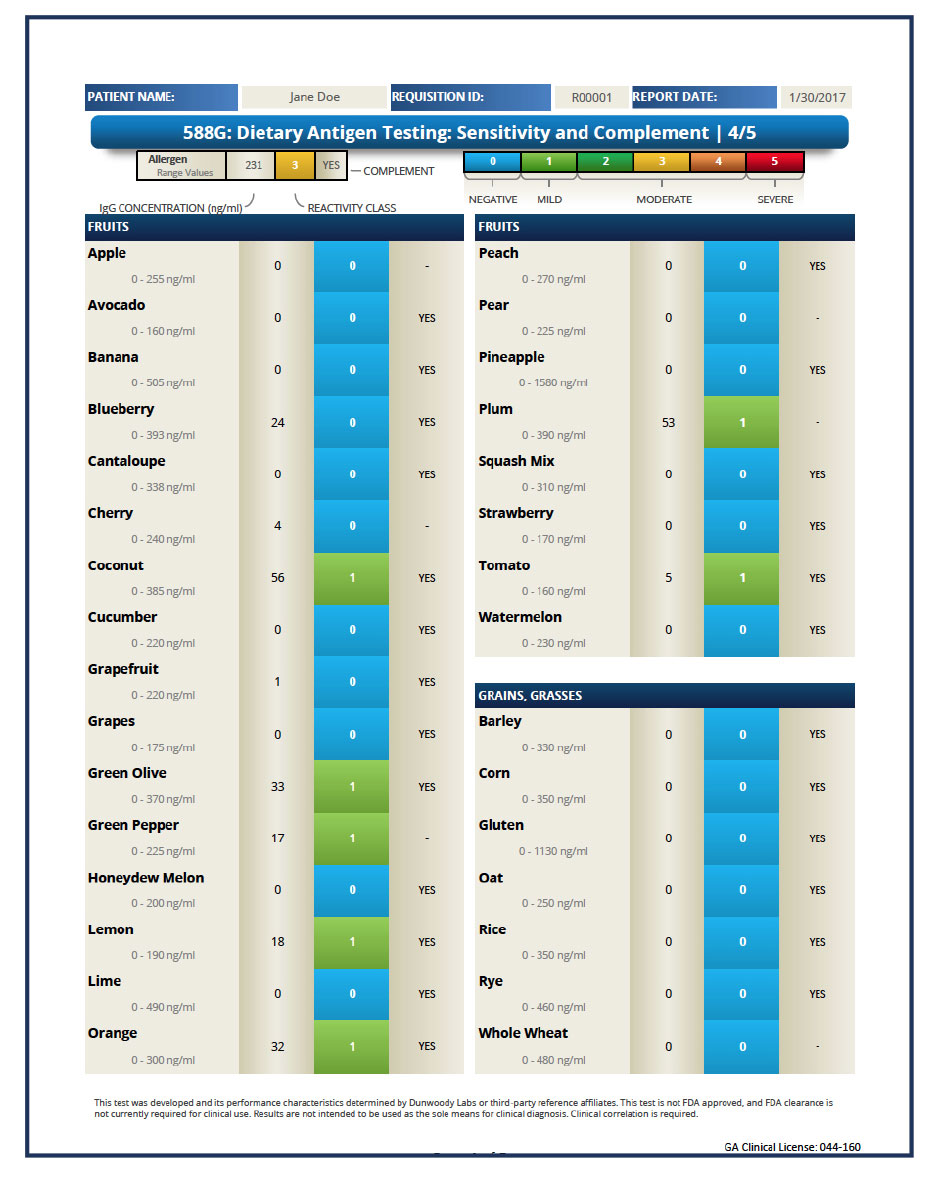Food Allergy Testing Program:
Dietary Antigen Complete
588G Food Sensitivities Profile
Why test for food sensitivities?
The immune system is your body's way of letting you know that you may be intolerant or sensitive to certain foods. A reaction to food is an abnormal response in the gastrointestinal tract that can occur for different reasons.
Sometimes there may not be enough of a particular enzyme to digest a certain food correctly. Other times, the immune system creates antibodies to proteins in specific foods.
When the immune system reacts to a food in this way, it can lead to inflammation and irritation of the intestine when eaten. Food allergies are distinct from food sensitivities.
Allergies can result in life-threatening reactions.
Sensitivities result in milder symptoms such as diarrhea, gas or bloating but also create inflammation that drives many pathologies and prevents improvement.
Allergic reactions are classified into four types. Our food allergy profile detects Type 11/111 responses, which are associated with a delayed allergic response that is mediated by an lgG response and immune complexes.
Within this immune complex, the complement component 3 (C3) is converted into C3d, which is an activator of the complement cascade. Our food allergy test is unique in that the test detects all classes of lgG and complement which results in a higher sensitivity.
What does the test tell me?
Your doctor may use the Food Sensitivities Profile to report on the degree of immune sensitivity and severity to each specific food. Our test is one of the only that looks not only at immunoglubulins (lgG) but also complement which amplifies its activity.
If you have food sensitivity symtoms such as diarrhea, gas, bloating, fatigue, constipation, or hives, then your doctor is looking to pinpoint which specific foods, preservatives may be causing them by running the Food Sensitivities Profile.
How is this test different?
Our profile is published in medical literature and is used in a number of clinical trials.
By looking at multiple types of immunoglobulins together as well as complement that amplifies its presence it is easier to know what is truly involved in your symptoms and health.
Symptoms associated with food sensitivities:
- Fatigue/Poor Sleep
- Constipation
- Gas or bloating
- Poor absorption of valuable vitamins and minerals
- Gastro esophageal reflux
- Hives, rash, eczema, or edema
- Joint pain and inflammation
- Headache or migraine
- Decreased immune function
- Diarrhea or soft stool
Dietary Antigen Allergy Test 588E
Dietary Antigen 588 E Test is an allergy test similar to the skin prick test measuring the reaction a patient has to a particular food protein. Our test analyzes the serum levels of lgE antibodies for 88 different food antigens, as well as lgG4 total, which acts a blocking agent. The serum allergy test has several advantages over a skin prick test, it is much safer for the patient, they are not being directly exposed to those antigens which can potentially cause a severe reaction. The serum test is also more sensitive and therefore more accurate.
lgE antibodies are one of five subclasses of antibodies in our immune system. Antibodies are proteins that attack antigens, such as bacteria, viruses and allergens to keep our body healthy. Sometimes the antibodies become confused and will attack food proteins as well. The lgE antibody response is the most common known food allergy response, it usually occurs immediately and can create severe symptoms such as swelling, hives, itching, and in some cases, anaphylaxis. These allergies have a circulation half-life of 1-2 days, are permanent allergies and they stimulate histamine release in the body.
lgG 4, which is a subclass of lgG, is another antibody in the immune system. lgG4 total antibody is important to look at as well due to the fact that this antibody acts as a blocking agent for an lgE reaction. lgG4 blocks lgE antibodies from binding to receptor sites and releasing histamine. During treatment, when an allergist gives injections for desensitization, it is to increase lgG4 to block lgE, not to lower lgE. When the qualitative amount of lgG4 is higher than lgE, it creates a blocking effect and keeps the lgE from causing anaphylaxis.
This presence of this blocking agent assists your practitioner in diagnosis and treatment by helping to determine the severity of your reaction to certain foods
The eight most common lgE foods are:
- Milk
- Egg
- Fish
- Shellfish
- Free nuts
- Peanuts
- Wheat
- Soy
Common lgE Food Allergy Symptoms:
- Tingling sensation in the mouth
- Swelling of the tongue and throat
- Difficulty breathing
- Hives
- Vomiting
- Diarrhea
- Abdominal cramps
- Drop in blood pressure
- Loss of consciousness
- Hay fever
- Asthma
- Eczema
- Psorisis
Blocking Potential

When lgG4 reaction is greater than the lgE reaction for a particular antigen, lgG4 blocks the lgE antibodies from binding to the receptor sites and releasing histamine thereby reducing severity of the symptoms associated with the lgE reaction. We refer to this as the blocking potential. |








